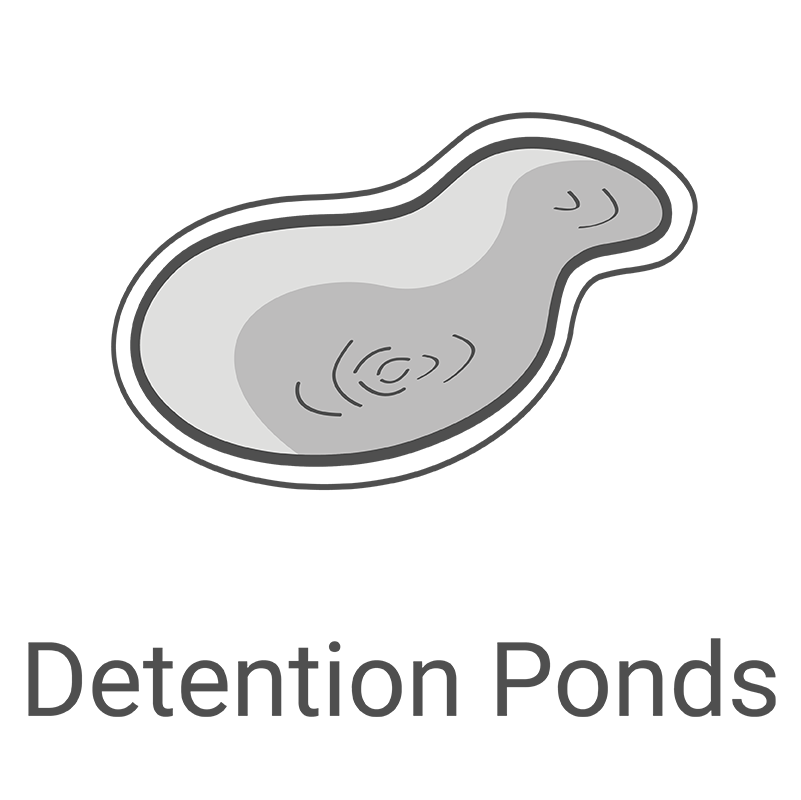GeoHECHMS®
HEC-HMS Workflow Automation
Speeds-Up Your Engineering Projects
Download Literature
HEC-HMS Workflow Automation
Speeds-Up Your Engineering Projects
Download Literature
GeoHECHMS greatly speeds up the creation, analysis, and review of stormwater models. It automates subbasin delineation, curve number (CN) computation using land use and soils maps, and lag time (time of concentration) computation. GeoHECHMS is a data wrapper to the industry-standard US Army Corps of Engineers HEC-HMS software using an AutoCAD compatible graphical user interface. Quickly compare different scenarios and alternatives, such as pre-development conditions with different post-development designs. Rapidly construct, design, analyze and compare detention and retention ponds. Both US and metric (SI) units are supported.

GeoHECHMS is an AutoCAD, MicroStation and ESRI ArcGIS compatible interactive 2D/3D graphical user interface data wrapper to the US Army Corps of Engineers HEC-HMS stormwater software.
Import existing Army Corps HEC-HMS models and quickly georeference them to real-world maps using included georeferencing tools.
Work with multiple HEC-HMS projects simultaneously using the Multiple Document Interface (MDI), including copying and pasting of stormwater structures and other data between HEC-HMS projects.
Interact graphically with all HEC-HMS model elements. Effortlessly create and edit subbasins, detention ponds, routing reaches and other model elements by clicking and dragging. Uncomplicated dialog boxes allow easy data entry and review.
Correct mistakes easily with unlimited Undo and Redo capability. Experiment with different engineering and management decisions. Rollback changes one at a time or select a group of changes from a visual selection list.
Toll-free 24-hour 7-day a week unlimited technical support by experienced HEC-HMS stormwater modelers is just a phone call away. Quickly resolve your stormwater modeling questions and complete your engineering project—our skilled, professional engineers are here to assist you.
Speed up stormwater projects with automated workflows to automatically delineate watersheds, compute curve numbers (CN), compute TOC & lag times, compute % impervious, assign design storms, size detention ponds, and generate engineering reports.
Integrate HEC-HMS directly with AutoCAD (including AutoCAD Civil 3D), Bentley MicroStation and ESRI ArcGIS terrain data. Export completed HEC-HMS models and results to AutoCAD, MicroStation and ArcGIS.
Interact graphically with all HEC-HMS model elements. Effortlessly
create and edit subbasins, detention ponds, routing reaches and other model elements by clicking and
dragging. Uncomplicated dialog boxes allow easy data entry and review.
Correct mistakes easily with unlimited Undo and Redo capability.
Experiment with different engineering and management decisions. Rollback changes one at a time or select
a group of changes from a visual selection list.
Toll-free unlimited technical support by experienced HEC-HMS
stormwater modelers is just a phone call away. Quickly resolve your stormwater modeling questions and
complete your engineering project—our skilled, professional engineers are here to assist you. Our
technical support team is available 24-hours/day Monday-Friday, and by email on weekends.
Speed up stormwater projects with automated workflows to
automatically delineate watersheds, compute curve numbers (CN), compute TOC & lag times, compute %
impervious, assign design storms, size detention ponds, and generate engineering reports.
Load, edit, and run multiple HEC-HMS models simultaneously. The
Multiple Document Interface (MDI) allows easy copying and pasting between models, quick comparisons of
input data and results between scenarios, and other modeling efficiencies. Models can be displayed in
tiled windows or tabbed views, providing greater productivity.
Delineate subbasins and watersheds from 3D digital elevation terrain
data. Utilize AutoCAD Civil 3D surfaces, MicroStation surfaces, contours, TINs, DTMs, DEMs, survey
points, LiDAR, and other external digital elevation terrain data.
Quickly size and design detention and retention ponds for different
design storms and engineering criteria. Develop outlet structures for different scenarios, considering
both water quality and design storm requirements.
Develop and compute HEC-HMS stormwater results directly within the
software, no external data processing required. Read and write standard US Army Corps HEC-HMS data
files, ready for regulatory agency submittal. In addition, HEC-1 models can be imported and updated to
HEC-HMS.
Compare different engineering models, such as existing and proposed
development, different detention pond designs and more. This allows stakeholders to evaluate
alternatives, allowing you to consider more innovative and environmentally sensitive designs.
Comprehensive, easy-to-read input data and output analysis reports
are automatically generated using provided drainage report templates. Reports can be customized to meet
reviewing agency requirements.
Reduce time wasted with imprecise data. Easily integrate field
collected data in varying formats along with CAD and GIS data to update the HEC-HMS model to accurately
reflect field conditions.
To improve productivity, the HEC‑HMS stormwater results computed
within GeoHECHMS will seamlessly migrate to HEC-RAS. This greatly increases the speed at which users can
perform HEC‑RAS flood studies, design bridge and culvert roadway crossings, compute dam failures, and
complete stream restoration and alignment projects.
Integrated stormwater design tools offer more efficient ways to
create and analyze a stormwater project, size and design detention ponds, analyze dam failures and more.
Update subbasin catchment boundaries dynamically as terrain data is changed. Quickly define detention
ponds and outlet structures using specialized stormwater tools.
Shift seamlessly between 2D and 3D viewing perspectives to clearly
identify modeling issues and make changes. Freely rotate, pan, zoom, and fly through the model to any
perspective to review subbasins, detention ponds, routing reaches and more.
Create stunning visualizations directly from the software of
different design alternatives to help better understand the impact of the design on the community and
the surrounding environment. Publish the HEC‑HMS model directly to Google Earth for even greater
visualization and understanding of the project.
Complete land use coverage is provided for USA, Canada, Europe,
Australia and many other parts of the world. For the USA, land coverage data is provided at a 100 x
100-foot grid cell size. This makes it extremely easy to compute composite curve numbers, time of
concentrations, lag times and more.
Complete percent imperviousness coverage is provided for the USA at
an approximate 100 x 100-foot grid cell size. This allows a more accurate stormwater model to be
developed, allowing urbanization effects to be directly incorporated into the stormwater model.
Utilize world-wide high-resolution 3D digital elevation terrain data
from map services for automated watershed delineation, computation of time of concentration and lag
time. Utilize web-based mapping services for aerial orthophotos, FEMA flood maps, watershed delineation,
river centerline alignment, and more.
Extract HEC-HMS routing reach cross sections from 3D digital
elevation terrain data. Utilize AutoCAD Civil 3D surfaces, MicroStation surfaces, contours, TINs, DTMs,
DEMs, survey points, LiDAR, and other external digital elevation terrain data. Automatically convert the
extracted cross section to an equivalent 8-point cross section.
For large models with numerous subbasins, routing reaches, junctions
and other stormwater elements, the software will automatically name the elements based upon
user-specified guidelines. The elements are named sequentially, by routing distance or incrementally.
Rapidly compute SCS time of concentration and lag time using flow
segments of sheet flow, shallow concentrated flow and channel flow. The software will automatically
compute overland flow lengths, slopes and travel times based upon digital terrain surfaces and land use
coverages.
The software will automatically determine the design storm and
corresponding precipitation based upon the project location anywhere within the USA, Canada, Austria,
and Germany. It will determine the design rainfall for the 1, 2, 5, 10, 25, 50, 100, and 500-year storms
by querying the Precipitation Frequency Data Server based on the project location.
Quickly compute composite SCS curve numbers (CN), Green Ampt and
percent imperviousness based upon aerial mapping, GIS polygon land use, or just by painting regions of
land use on the screen. The software will automatically compute a weighted average of the different land
uses and assign it to each subbasin.



 1-800-301-02-955
1-800-301-02-955
 608-729-5100
608-729-5100
(US and Canada)
 [email protected]
[email protected]
 +1 608-729-5100
+1 608-729-5100
–
–
–Tel:
CivilGEO India
Graphix Tower, A-13 A
3rd Floor, Sector 62
Noida, Uttar Pradesh 201309
IndiaTel:
1-800-301-02-955 or
+91 022-3831-8601
Copyright © CivilGEO, Inc. All rights reserved. The CivilGEO logo, “GeoSTORM”, “GeoHECHMS”, “GeoHECRAS”, and “Ready To Engineer” are registered trademarks of CivilGEO,Inc.
All other brands, company names, product names or trademarks belong to their respective holders.
We use cookies to give you the best online experience. By agreeing you accept the use of cookies in accordance with our cookie policy.
When you visit any web site, it may store or retrieve information on your browser, mostly in the form of cookies. Control your personal Cookie Services here.
Oops! We could not locate your form.
